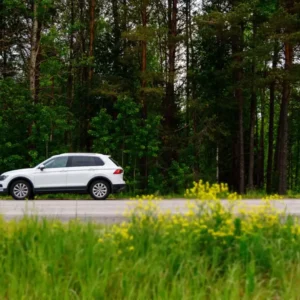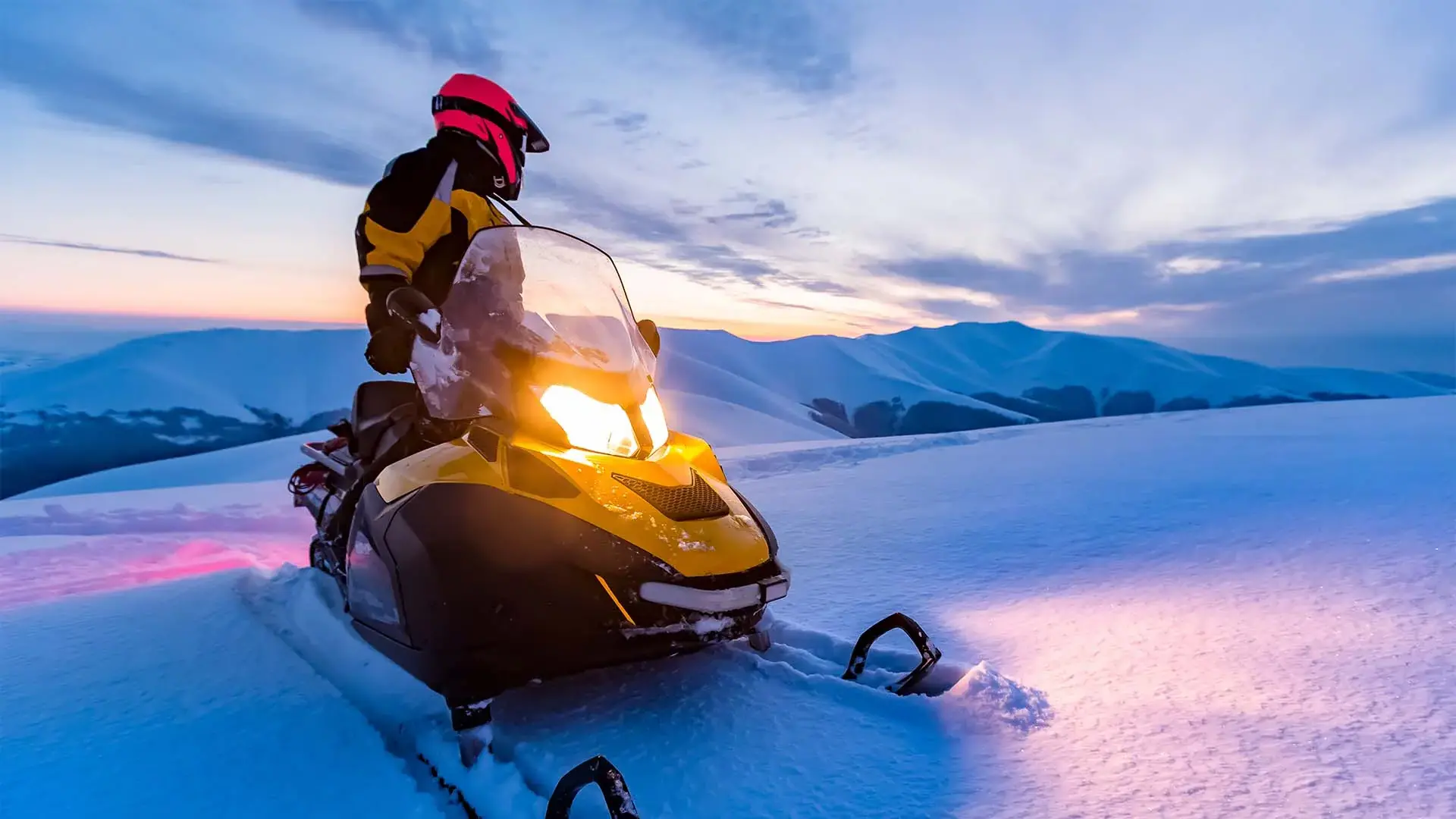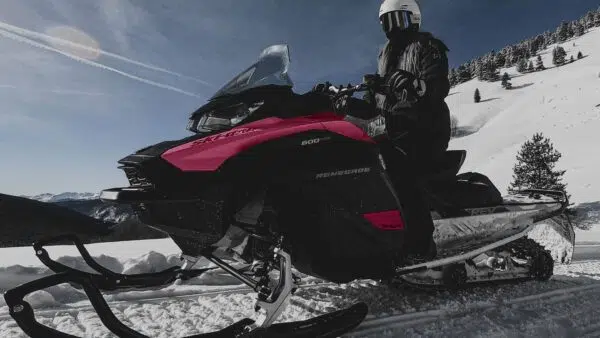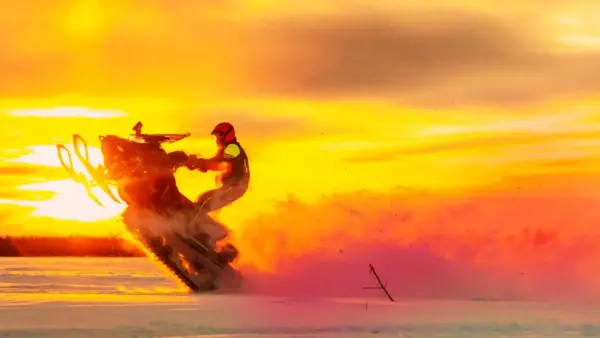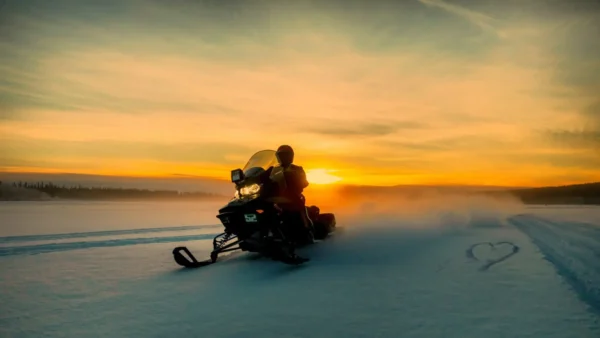Snowmobiles are a popular way to get out and enjoy all Canadian winters have to offer. There are more than 150,000 sleds registered in Ontario, and about 600,000 across the country. For those new to the sport, there are six different types of sled to choose from, and countless individual models. Some can reach speeds of close to 200 km/h, but in Ontario, 50 km/h is the limit.
Snowmobiling in Ontario can be great fun. Every winter, hundreds of thousands of Ontarians get out on more than 30,000 km of trails. Snowmobiling – or sledding – combines the freedom of a motorcycle with the rugged adventurousness of an ATV. If you live in the great white north, there’s no better way to experience winter.
So what makes snowmobiles tick, and what does it take to safely ride one?
History of snowmobiles in Canada
The first vehicle that could be called a snowmobile was invented in Maine in 1908, but it was developed with the intention of hauling logs for the lumber industry.
The person most often credited with the invention is Canadian Joseph-Armand Bombardier, who was in his teens in 1922 when he first strapped a Ford engine to two wooden sleds. In 1934, Bombardier’s young son died because the family was unable to get him to the hospital in wintertime, and that motivated the inventor. In 1935, he put together a sled that used caterpillar tracks and was steered by skis. The earliest users were country doctors and priests.
American Carl Eliason was also working on his own motor toboggan as early as 1924 in Wisconsin. He patented his invention in 1927 and built snowmobiles throughout the 1930s. Polaris started up in the 1950s, and Bombardier launched the iconic Ski-Doo in 1959.
How much do snowmobiles cost?
New snowmobiles cost between $3,000 and $25,000, depending on the brand and model you choose. Kids’ sleds will run you $3,000-$4,500. Adult models start around $8,500. The most expensive performance sleds are over $22,000. The average price you would pay for a new adult snowmobile is $12,600. Used sleds vary in price from around $2,000 to $10,000.
How much for insurance?
We ran quotes for Canada’s most popular sleds. For riders with fairly clean records (both riding and driving), we found that annual premiums ranged from $550 to $1,050 and that the price of the sled and the size of the engine (CCs) impacted the cost of insurance. You can expect your yearly premium to be 5-7% of the price of the sled. If you have more than a couple tickets or at-fault accidents, it will cost at least 50% more than that. Interestingly, all tickets (riding and driving) count against you, but only at-fault accidents related to sledding affect your rate. Driving at-fault accidents do not.
Snowmobile insurance pricing is a little different than car insurance. Generally, insurers look at a shorter list of factors to arrive at a premium. For instance, your gender and marital status don’t matter.
It should be noted that not all insurance companies insure snowmobiles. But never fear, Mitch works with a number of top insurers that do. Northern Ontario residents get a 10% discount, and you could save an extra 15-20% if you insure your snowmobile together with your home and car.
Also note that if you have kids between the age of 12 and 16 who are riding with an MSVOL certificate, they are not covered by a standard snowmobile policy. You’ll need to add an OPCF 32 endorsement to your policy, which will cost a little more.
Just like for cars and motorcycles, the insurance industry guarantees that anyone who has a legal snowmobile can get coverage through Facility Association, a not-for-profit company that is funded by all of the insurance companies operating in the province. Premiums are always going to be higher than if you get coverage with a regular insurer.
A few reasons you might need to get insurance from Facility Association:
- If you’ve made modifications to the sled to increase speed and power
- If you’re a novice rider trying to insure a sled over 800 cc
- If you have more than a couple of tickets or at-fault accidents on your record
- If you’ve been cancelled by your insurance company for non-payment
What does snowmobile insurance cover?
To ride a snowmobile legally, you need to have the same coverages that are applicable to cars and motorcycles in Ontario. Namely:
Third-Party Liability
This is financial protection for you if you are responsible for killing or injuring another person while sledding, or damaging their property. It also pays your legal fees. The minimum coverage by law is $200,000, but in our litigious society, we recommend $1 or $2 million. It doesn’t cost that much more.
Statutory Accident Benefits (AB)
This pays for medical and rehab costs beyond what government health insurance covers, if you are injured in a snowmobile accident. It also provides other benefits that you’ll need if you’re seriously injured, including income replacement if you can’t work, the cost of having someone care for you at home, and even the cost of having someone care for your kids or elderly parents if you’re unable to do so yourself. Lastly, Accident Benefits include a death benefit, payable to your family, if you should die in a sledding accident.
Direct Compensation – Property Damage (DCPD)
If someone else is responsible for an accident, this coverage ensures your sled gets repaired or replaced without you having to sue the at-fault rider. There’s also no deductible.
Uninsured Automobile
Uninsured auto coverage protects you if the person who is at fault for an accident leaves and can’t be identified, or if they don’t have insurance.
Exclusions and limits
Some insurers will only sell you snowmobile insurance with an OPCF 9 endorsement, which excludes marine use. That means no riding on frozen lakes and rivers. Some may also insist on an OPCF 19 endorsement, which limits how much they’ll pay if your sled is destroyed or lost. Your broker should let you know about all exclusions and policy limits.
Optional coverages
In addition to the mandatory coverages required by law, it’s also a great idea to purchase comprehensive coverage, to protect your sled from fire, theft, vandalism and weather damage that might occur, even when you’re not riding. And of course, you probably want collision coverage to repair or replace your sled if you’re at fault for an accident. These are both subject to a deductible, usually $500 or $1,000.
Mitch also recommends a family protection endorsement which basically applies your liability limits to anyone who crashes into you. So if you have $2 million in liability coverage and you or a family member are injured by an at-fault driver with no insurance, or say the minimum $200,000, you can sue them for up to $2 million. This coverage is usually quite affordable – $20 a year on average, and well worth it.
Lastly, when you buy insurance for your sled, your broker should also offer you the option to increase your Accident Benefits coverage. For an additional premium, you can increase the limits for income replacement, attendant care, etc.
Can you save money by cancelling your insurance in the summer?
The short answer is no. In Canada, snowmobile insurance, like motorcycle insurance, is priced by the month. The insurance company knows you only ride during certain months, so they charge you 75% of your annual premium during December, January and February.
Here’s the annual breakdown:
| Month | Percentage of Annual Premium Charged |
| January | 25% |
| February | 25% |
| March | 15% |
| April | 0% |
| May | 0% |
| June | 0% |
| July | 0% |
| August | 0% |
| September | 0% |
| October | 0% |
| November | 10% |
| December | 25% |
So if you buy your insurance on December 1, then try to cancel on April 1, you’ve used up 90% of your annual premium, but you’ve probably only paid 25% to that point. If your annual premium is $500, and you’re paying $42 a month, cancelling will mean you have to pay off the remaining $325 all at once. Plus your sled won’t be insured for fire and theft over the summer. It just doesn’t make sense.
Who rides snowmobiles and where?
It’s fitting that Quebec is considered the birthplace of the snowmobile, because it is still by far the Canadian leader in snowmobile registrations, with more than 230,000. That’s close to 40% of all the snowmobiles in Canada. Ontario has its fair share as well, with more than 155,000. Most snowmobiles today are used for pleasure riding, although there are special commercial sleds that can tow 1,500 pounds or more.
| Province or territory | Registered sleds[1] |
| QC | 234,061 |
| ON | 155,200 |
| BC | 37,800 |
| MB | 36,928 |
| NL | 36,800 |
| AB | 32,500 |
| SK | 21,806 |
| NU | 12,900 |
| NB | 11,500 |
| NWT | 9,700 |
| NS | 7,800 |
| YT | 822 |
| PEI | 312 |
Get a snowmobile insurance quote in minutes.
How fast are snowmobiles?
The average top speed of adult snowmobiles currently sold in North America is anywhere between 110 and 193 km/h. Kids’ sleds go much slower, and are usually equipped with a speed limiter that doesn’t allow them to go over 50 km/h. The smallest kids’ sleds don’t even go that fast, with some only reaching top speeds around 13 km/h.
Just like cars though, snowmobile speed is limited more by the law than anything else. In Ontario, the speed limit is 50 km/h on most trails and on roadsides where sleds are permitted if the posted speed limit is 55 km/h or more.
When crossing the road, sledding through public parks or exhibition grounds, or riding roadside where the posted limit is 50km/h or less, the limit for sledders is 20km/h.
How long do snowmobiles last?
Snowmobiles typically last about 30,000 kilometers. Based on an average riding season, that means your sled could be with you for 20 years or so. Of course, it depends on how much you ride and how well you maintain the sled.
Are snowmobiles safe?
Like any motorized vehicle, riding a snowmobile involves a certain amount of risk, and safety is ultimately in the hands of the rider. Here are a few stats that put snowmobile safety in perspective:
- Every year, on average, 73 people are killed in snowmobile accidents in Canada.
- 89% of people killed in snowmobile accidents are men
- 80% of fatal sledding accidents involve a single snowmobile
- 34% involve excessive speed
- 49% involve drug or alcohol use
- 35% occur after dark
- 11% involve a sled going into water
- 75% or more of fatal accidents are when the driver is alone on the snowmobile
What these stats tell us is that you can increase the chances of a safe riding experience if you only ride when you’re sober, and keep your speed down. We also recommend that you wear the right gear (including a helmet, warm clothes and something that floats), change your helmet every 3-5 years, and check ice conditions before going out on frozen rivers and lakes. (Experts say that ice needs to be at least 25 cm thick to support the average sled.)
What are the basic requirements to ride?
There are a few checkboxes you’ll have to tick before heading out on the trails. Here are the legal requirements to ride a snowmobile in Ontario:
- To ride anywhere but your own private property, you have to be at least 12 years old.
- If you’re between 12 and 15 years old, you need to have an MSVOL certificate.
- If you’re 16 or older, you can ride with an MSVOL, or a valid driver’s licence.
- Your sled must be registered with the MTO. Some snowmobile dealers will arrange this for you.
- To use public trails, you’ll need to purchase a trail permit. The annual cost is $200 for most sleds.
- You need to wear an approved helmet. Look for a DOT, SNELL or ECE certification sticker, usually on the back.
Other than the legal stuff, there are some common sense items you should have with you whenever you’re snowmobiling. Warm clothes come to mind. Here’s a list of other stuff you might want to bring.
What are the different types of snowmobiles?
Looking for a snowmobile? They’re not all the same. There are different styles depending on the kind of riding you plan to do.
Trail
Trail snowmobiles are quite affordable, lightweight, handle well and tend to be good starter sleds for new riders.
Examples:
- Arctic Cat ZR 6000 Limited
- Polaris Indy XC
- Ski-Doo MX-ZX 600
- Yamaha SXVenom
Crossover
Crossover models are a step up from trail snowmobiles. They have more power and a more advanced suspension. They also have a longer track that will allow you to go off trail a bit into the deeper snow if you need to.
Examples:
- Arctic Cat Riot X
- Polaris Switchback series
- Ski-Doo Renegade series
- Yamaha Sidewinder X-TX
Touring
Think of a touring snowmobile as a Harley Davidson or a Cadillac. It’s a premium sled, built for advanced riders, with plenty of power and acceleration when you need them, but these sleds are created with comfort and ride as the top priority. They are bulkier and don’t handle quite as well as a performance snowmobile, but if you like to go for long rides over fairly even terrain, you want a touring sled.
Examples:
- Arctic Cat XR Touring
- Polaris TITAN Adventure
- Ski-Doo Grand Touring
- Yamaha Transporter Lite 2-UP
Deep snow or mountain
These sleds are also for advanced riders and have a rugged sporty look. The design is pretty narrow when compared to most other snowmobiles. Mountain snowmobiles are built to handle heavy snow powder and steep inclines.
Examples:
- Arctic Cat M Mountain Cat Alpha One
- Polaris RMK series
- Ski-Doo Summit series
- Yamaha Mountain Max series
Performance
These offer speed, power, and smooth suspension, much like you’d expect from a high-performance sports car. They are lots of fun for an experienced rider, but probably a little too much to handle for beginners.
Examples:
- Arctic Cat ZR 9000 Thundercat
- Polaris Indy 850 XC
- Ski-Doo MXZ X series
- Yamaha Sidewinder L-TX LE
Utility
If a touring sled is a Cadillac, think of a utility sled as an F-150. If you need a snowmobile for towing, a utility sled is right up your alley. Lots of power and an extra wide track mean that you and your load will get where you’re going. If you’re just riding for fun, this is probably not your sled.
Examples:
- Alpina Superclass 1.2L VVT 12V
- Arctic Cat Norseman X 8000
- Polaris Titan XC
- Ski-Doo Skandic
- Yamaha VK Professional II
Types of tracks and benefits
The track is what keeps your heavy snowmobile from sinking in soft snow, the same way that long, flat skis and wide, flat snowshoes do for you. They distribute the weight over a larger area. Snowmobile tracks also give you extra grip on surfaces like snow and ice, where regular wheels would slip.
Tracks can come in different widths and lengths depending on the type of snowmobile. But note that you can’t put a longer or shorter track on your sled. Every sled comes with a standard track length and width.
Track length – The shortest tracks for adult snowmobiles are 121-129 inches (3.07-3.28 metres). You’d likely see these on sleds with weaker motors because the shorter track allows them to accelerate more quickly. The lugs or paddles on the track that grip the snow tend to be shorter as well, and for that reason, sleds with short tracks are not recommended for deep snow. Stay on the well-groomed trails.
Medium-length tracks (136-146 inches or 3.45-3.71 metres) are better for deeper snow, provide more stability and a smoother ride. That said, anything between 120 and 140 inches is just fine for trail riding.
Long tracks (151+ inches) can be found on mountain and utility sleds, and any snowmobile built for more than one rider. Longer tracks also tend to have longer lugs.
Before you go thinking that longer tracks are just better, keep in mind that a longer track is not quite so agile for tight cornering, and also won’t accelerate as quickly. If you generally ride on groomed trails, you should also know that the longer lugs will wear down faster. It’s a bit like using winter tires in the summer.
Studded Tracks – One of the most common modifications you can make to your sled is adding studs to the track. This is done primarily for safety reasons and provides better traction and more reliable stopping on the iciest surfaces.
2-stroke or 4-stroke?
The original snowmobiles had 2-stroke engines that have a simpler design, are generally cheaper, and produce more power. Some current sleds are still 2-stroke. They run on a mix of gas and oil.
Since the early 2000s, some manufacturers have gone to a 4-stroke engine. These sleds are generally a little more expensive to buy because the design is more complex. The sleds are also heavier. The advantage is that these sleds are more fuel efficient and will typically last longer.
Common Accessories
Every rider has their own preferences in terms of what riding gear they consider worth investing in. The two most important considerations are safety and warmth.
If you’re going for a short ride and are not a regular sledder, you can probably get away with just a warm winter coat, long johns, water resistant pants, winter boots and gloves, and of course, an approved helmet.
If you’re going to be out on the trails for hours on end, and especially if you like to go off trail, here’s some custom gear you may want to invest in:
- Specialized snowmobile boots and gloves
- Handlebar heater and thumb warmer kit
- Handlebar muffs
- Floatable jacket
- Armored shorts or pants
- Chest and back armor
- Shoulder, elbow and wrist guards

Insurance tip:
If you own a lot of specialized equipment, it’s a good idea to let your broker know.
Coverage is available for your gear at a small additional premium.
Remember that snowmobiling is a winter sport, and as such, you want to be prepared for whatever weather is thrown at you. Here’s some other stuff you might want to bring along when you go sledding.
How often do I need to service my sled?
It really depends on how much you ride, but most sleds that are used recreationally for less than 4,000 km a year should generally require only one annual check-up. That maintenance should include:
- Changing the engine oil and filter
- Changing the chaincase oil
- Lubricating all moving parts of the sled
- Checking ski alignment
- Checking for wear and tear, especially on parts of the sled that might come into contact with the ground
Can I get a quote for insuring my sled?
We thought you’d never ask. Our brokers would be happy to get you some quotes. It should only take 15 minutes. If you like what you hear, we could have you out on the trails today! Give us a shout.
Looking for snowmobile insurance?
Speak with a Mitch Insurance broker today to get a quote on Ontario snowmobile insurance.
Call now
1-800-731-2228


